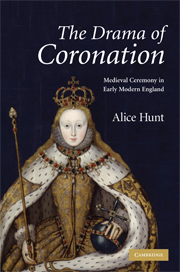Book contents
- Frontmatter
- Contents
- Preface
- Note on style and dates
- List of abbreviations
- Introduction: the ‘idol’ ceremony of coronation
- Chapter 1 Why crown a king? Henry VIII and the medieval coronation
- Chapter 2 ‘Come my love thou shalbe crowned’: the drama of Anne Boleyn's coronation
- Chapter 3 ‘But a ceremony’: Edward VI's reformed coronation and John Bale's King Johan
- Chapter 4 ‘He hath sent Marye our soveraigne and Quene’: England's first queen and Respublica
- Chapter 5 ‘A stage wherin was shewed the wonderfull spectacle’: representing Elizabeth I's coronation
- Epilogue: ‘Presume not that I am the thing I was’
- Notes
- Bibliography
- Index
Chapter 4 - ‘He hath sent Marye our soveraigne and Quene’: England's first queen and Respublica
Published online by Cambridge University Press: 22 September 2009
- Frontmatter
- Contents
- Preface
- Note on style and dates
- List of abbreviations
- Introduction: the ‘idol’ ceremony of coronation
- Chapter 1 Why crown a king? Henry VIII and the medieval coronation
- Chapter 2 ‘Come my love thou shalbe crowned’: the drama of Anne Boleyn's coronation
- Chapter 3 ‘But a ceremony’: Edward VI's reformed coronation and John Bale's King Johan
- Chapter 4 ‘He hath sent Marye our soveraigne and Quene’: England's first queen and Respublica
- Chapter 5 ‘A stage wherin was shewed the wonderfull spectacle’: representing Elizabeth I's coronation
- Epilogue: ‘Presume not that I am the thing I was’
- Notes
- Bibliography
- Index
Summary
In histories of the Reformation, the accession of Mary is often depicted as the stumbling block, a step backwards and an aberration. Unequivocally Catholic, her reign has been classified as disastrous, unimaginative and ineffective. But Mary's coronation on 1 October 1553, and the extraordinary circumstances surrounding her accession, position her coronation as a crucial link between Edward VI's and Elizabeth I's ceremonies, with significant implications for the future of monarchical politics and purpose of sacred royal ceremonies.
Mary's reign is still traditionally viewed through the prism of her religion, but this chapter argues for the inextricability of three major issues surrounding Mary's accession: legitimacy of birth, legitimacy of gender and legitimacy of religion. Mary was England's first acknowledged queen regnant. She was also Catholic and, in some eyes, legally a bastard. Furthermore, the law meant that Mary could be declared Supreme Head of the Church of England. There was no precedent for a queen regnant, let alone for a female and Catholic supremacy. As a possible solution to this problem, Mary's newly formed Council came up with an unusual plan whose significance has, until now, been overlooked by critics. Certain key members of the Council proposed to postpone Mary's coronation until after Parliament had opened and safely declared her queen. Such a reversal of the established sequence of events at the beginning of a monarch's reign was unprecedented, and it signals a fundamental turning point in the sixteenth century.
- Type
- Chapter
- Information
- The Drama of CoronationMedieval Ceremony in Early Modern England, pp. 111 - 145Publisher: Cambridge University PressPrint publication year: 2008

